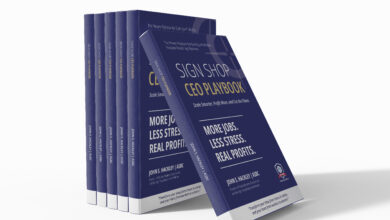One of the most requested ideas that shop owners need the most help with is the concept of pricing. After all, nobody wants to work for free, and everyone wants to maximize the profit from their work.
You see this constantly in the industry Facebook groups. Some random shop owner posts a request for a price comparison with a shirt blank, the number of colors, and the number of shirts. “Where are you on this?” they ask. I’m always amazed at this.
No answer that anyone will provide can be accurate because everyone has a different set of circumstances for their business. Different costs. Different customers. Different skill sets and efficiencies. Different geographical markets. Different ideas on business. Any answer will be incorrect because no two shops are identical.
Another way to analyze your business pricing is based on the profit outcome you want to achieve. You don’t need the opinions of others, as the idea here is built on the result you want.
This is the metric called value per hour (VPH).
Unveiling the value per hour concept
The idea here is a classic for business: how to generate the maximum value within a given time frame.
Simply put, VPH measures the average revenue generated from a single piece of equipment in one hour of operation. This could be one of your direct-to-garment (DTG) machines. A heat press for direct-to-film (DTF). Screen printing or embroidery equipment. Maybe even a laser for handling those leatherette patches. Whatever you use in your shop to produce the orders you sell. You can even add ancillary work such as polybagging, hangtagging, or fulfillment.
Why does this matter?
Here’s the thought: The one commodity you have to spend that you can’t get back is your time. Every minute that ticks away in your business should be spent maximizing money for the company. When you look at the orders you are saying “yes” to producing, are they generating the most money for the business possible?
For example, one of your embroidery machines was booked with $6,573 worth of work over 40 operational hours last week. The VPH of that machine was $164.33 per hour.
Another embroidery machine only produced $2,487 worth of work over the same 40 hours. The VPH of that machine was $62.18. Why? The difference between the two pieces of equipment was $102.15 per hour. If we annualize the difference, this could cost your shop a lot of money. (2,080 hours per year x $62.18 = $129,334.40) Is the reason behind the difference because of the type of work scheduled for the machine? Maybe the operator cannot produce more jobs per day. What is the boat anchor to the equipment performance here?
This is a big question. It looms even more significant if we consider that maybe $164.33 isn’t a good value. Perhaps the shop target is $300 or $500 per hour instead.
What is your shop VPH goal versus what is being achieved daily? Do you know?
Work half as hard for twice as much
This fits nicely when the shop first considers gross and net profit goals. Most business owners will use their total revenue to benchmark their success when asked about their company.
“We are a $2 million company,” they will say, or something similar. Maybe you cite your total revenue to other businesspeople this way. Total revenue is akin to a vanity metric.
- Company A is a $2 million company with a net profit of 10%, or $200,000.
- Company B is a $1 million company with a net profit of 40%, or $400,000.
Which one is better? Company B, of course. They work half as hard and make twice as much. One way they can achieve this is by focusing on the outcome of their work. Better business decisions can be made when focused on the correct bullseye.
Ask yourself this question: What do you want regarding net profit? At the end of this year, what is that number?
Time is money: A closer look at your pricing
The adage “time is money” can take on a tangible form in our industry. For example, let’s say that a piece of equipment in your shop has a VPH of $300. It can be anything, but this is a good number as it easily equates to $5 per minute.
For every idle minute or hour of underutilization, potential revenue slips away. We all know that shops only make money when something is being decorated. Have you ever walked out to your shop floor and watched production for any length of time?
After you finish reading this article, do yourself a favor and do this experiment. Pretend one of your machines has a value of $300 per hour. Observe it in action. Every time it is idle, take out your wallet and throw a $5 bill onto the floor.
How big is that pile of bills at the end of an hour? At the end of the shift? If that makes you nervous, consider this. You are already doing this every day, but you are not tossing $5 bills around in reality. When inactive for an hour, a machine with a VPH of $300 translates to a missed revenue opportunity of $300.
How many different pieces of equipment do you have in your building? Have you set a VPH number for each? How many are idle because you do not have a consistent sales process to load each machine with constant work?
In some situations, your idle time for some equipment outpaces the downtime when it is operating. Nauseous yet?
It goes even further. When you start to dig into VPH inconsistencies, factors such as downtime, setup time, maintenance, operator skill, and even the types of work booked to the machine start coming into focus.
Minutes can translate into dollars.
Essential concepts to understand VPH
- Understanding order value. VPH can offer insights into the profitability of orders. For example, a high VPH can indicate a more lucrative order. This could signal a type of client, order, or decoration method deserving more focus. What if your sales team focused on obtaining orders with a higher VPH? You could be more like Company B in the example cited earlier.
- Downtime cost. Are you bleeding revenue opportunities? If a machine with a VPH of $300 remains inactive for five hours, that is a loss of $1,500 for the day. What is this idea costing you per year?
- Setting a financial baseline. Do yourself a favor. Take all the jobs you produced on one of your machines yesterday and add the total revenue. Then, divide that by the hours worked for the crew. VPH can serve as a financial compass for your business. Are you on the right track, or do you need a recalibration of the work you accept or the pricing you use? This is a binary idea. Either you are operating with a good VPH number, or it is a bad VPH number. You decide!
Best practice tips for VPH tracking
- Be consistent. Measure every day with all production lines. Every job counts. Sometimes, smaller jobs can collectively yield a higher VPH than one large order. Or maybe it is the reverse. This is why you must look at what is booked in your shop and ascertain your truth.
- Record your metrics. You need to learn the answer to the question, “Why aren’t we printing?” (or lasering, or embroidering, etc.) What is keeping your team from having more up time in their day? Get your production numbers recorded and graphed. You can’t manage what you don’t measure.
- Review and adjust. Keep asking this question: Is there a type of garment, decoration method, customer, quantity, or type of order that will consistently provide higher profits and keep your VPH higher? What if your sales team concentrated on selling this type of work more often? Would that significantly affect your net profit goals for the year? What is the cost of doing nothing?
Embracing the power of VPH
- Net profit margin focus. Value per hour, paired with accurate and timely net profit margin numbers, can provide a richer business narrative. You only have so many hours in the day. What is the most profitable type of work you can sell for each piece of equipment? Think about this: what if you could determine the “sweet spot” for your work based on profitability and VPH?
- Automation and equipment. Yes, you probably have machines that are paid off and are being used every day. What if new equipment, techniques, automation, or ideas could ramp up your VPH on the shop floor? It is a fact that newer equipment can run better, have less downtime, and possibly produce more units per hour. If your goal is to increase your VPH, would the capital expense increase your productivity and profitability? Can you get an ROI in under 18 months?
- Employee training. Leveling up your employees with new skills and expertise is a great way to handle more tasks each day. More trained staff can often boost the VPH by reducing production times and enhancing effectiveness. Imagine what might happen if your entire team boosted your numbers daily. This happens with an organized and on-purpose training program. Do you have one?
Embracing the VPH narrative
This is about rethinking how you do business. Your current customers may not be providing the maximum value per hour for the work you are accepting.
If so, you don’t have to drop them like a hot potato. You need to reorganize, research, and rewrite (or write if you don’t have one already) a business plan targeted to customers who will provide you with better and more lucrative work.
I know. It sounds crazy. But I will tell you that there are shops out there that are not working nearly as hard as you are, but they are making larger profit percentages because they have moved away from low value per hour work. You can do this!




